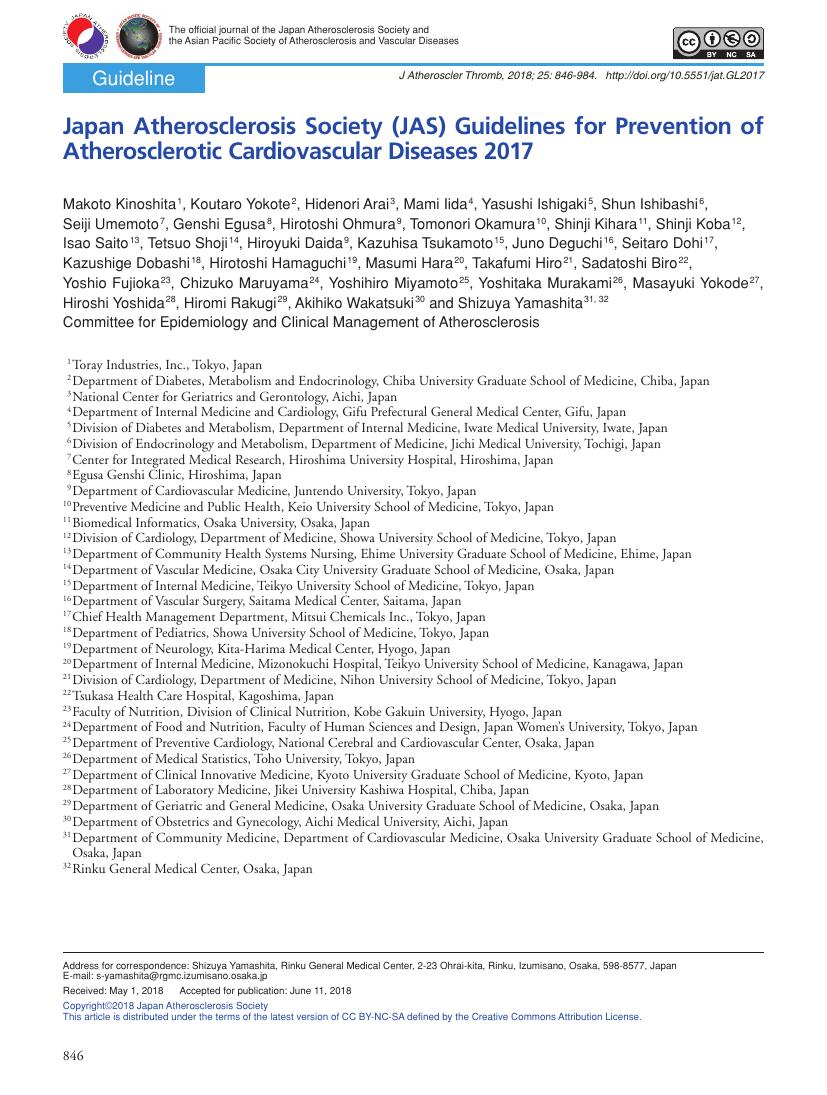- 著者
- Makoto Kinoshita Koutaro Yokote Hidenori Arai Mami Iida Yasushi Ishigaki Shun Ishibashi Seiji Umemoto Genshi Egusa Hirotoshi Ohmura Tomonori Okamura Shinji Kihara Shinji Koba Isao Saito Tetsuo Shoji Hiroyuki Daida Kazuhisa Tsukamoto Juno Deguchi Seitaro Dohi Kazushige Dobashi Hirotoshi Hamaguchi Masumi Hara Takafumi Hiro Sadatoshi Biro Yoshio Fujioka Chizuko Maruyama Yoshihiro Miyamoto Yoshitaka Murakami Masayuki Yokode Hiroshi Yoshida Hiromi Rakugi Akihiko Wakatsuki Shizuya Yamashita Committee for Epidemiology and Clinical Management of Atherosclerosis
- 出版者
- Japan Atherosclerosis Society
- 雑誌
- Journal of Atherosclerosis and Thrombosis (ISSN:13403478)
- 巻号頁・発行日
- vol.25, no.9, pp.846-984, 2018-09-01 (Released:2018-09-01)
- 参考文献数
- 999
- 被引用文献数
- 347 534
- 著者
- Atsushi Kobori Yasuhiro Sasaki Misun Pak Masahiro Ishikura Ryosuke Murai Taiji Okada Toshiaki Toyota Tomohiko Taniguchi Kitae Kim Natsuhiko Ehara Makoto Kinoshita Yasuki Kihara Yutaka Furukawa
- 出版者
- The Japanese Circulation Society
- 雑誌
- Circulation Journal (ISSN:13469843)
- 巻号頁・発行日
- vol.86, no.2, pp.290-298, 2022-01-25 (Released:2022-01-25)
- 参考文献数
- 27
- 被引用文献数
- 4
Background:Outcomes of cryoballoon ablation for persistent atrial fibrillation (AF) are unclear, especially in Japanese patients, so the effectiveness and safety of cryoballoon ablation in clinical practice were retrospectively compared with those of contact force-sensing radiofrequency (CFRF) ablation including the high-power protocol.Methods and Results:Consecutive patients with persistent AF were reviewed, and 253 and 265 patients who underwent cryoballoon and CFRF ablation, respectively, were enrolled. The primary endpoint was atrial arrhythmia recurrence. The secondary endpoints were periprocedural complications and repeat ablation. The rate of additional left atrial (LA) ablation after pulmonary vein isolation (PVI) was similar between groups (68.8% cryoballoon vs. 74.0% CFRF, P=0.19). Freedom from atrial arrhythmia recurrence was comparable between groups over a follow-up of 25.5±12.5 months (72.3% cryoballoon vs. 69.8% CFRF; adjusted hazard ratio (HR) 0.85, 95% confidence interval (CI) 0.59–1.21, P=0.36). Outcomes were similar in the subgroups of PVI alone and PVI plus additional LA ablation. LA posterior wall isolation, absence of defragmentation, and low creatine clearance, but not catheter selection, were associated with the primary endpoint. Periprocedural complications (adjusted HR 0.73, 95% CI 0.34–1.54, P=0.41) and repeat ablation (adjusted HR 1.11, 95% CI 0.71–1.74, P=0.64) were similar for both procedures.Conclusions:Cryoballoon ablation for persistent AF in Japanese clinical practice had acceptable outcomes comparable to those of advanced CFRF ablation.
